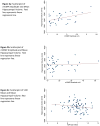Vestibular Function and Hippocampal Volume in the Baltimore Longitudinal Study of Aging (BLSA)
- PMID: 29889787
- PMCID: PMC5999049
- DOI: 10.1097/MAO.0000000000001838
Vestibular Function and Hippocampal Volume in the Baltimore Longitudinal Study of Aging (BLSA)
Abstract
Objective: This study evaluated whether reduced vestibular function in aging adults is associated with lower hippocampal volume.
Study design: Cross-sectional study.
Setting: Baltimore Longitudinal Study of Aging, a long-running longitudinal cohort study of healthy aging.
Patients: Eligible participants were aged ≥ 60 years and had both vestibular physiological testing and brain magnetic resonance imaging at the same visit.
Intervention: Vestibular function testing consisted of the cervical vestibular-evoked myogenic potential (cVEMP) to assess saccular function, ocular VEMP to assess utricular function, and video head-impulse testing to assess the horizontal semicircular canal vestibulo-ocular reflex.
Main outcome measure: Hippocampal volume calculated using diffeomorphometry.
Results: The study sample included 103 participants (range of 35-90 participants in subanalyses) with mean (±SD) age 77.2 years (±8.71). Multivariate linear models including age, intracranial volume, sex, and race showed that 1 μV amplitude increase of cVEMP was associated with an increase of 319.1 mm (p = 0.003) in mean hippocampal volume. We did not observe a significant relationship between ocular VEMP amplitude or vestibulo-ocular reflex gain and mean hippocampal volume.
Conclusions: Lower cVEMP amplitude (i.e., reduced saccular function) was significantly associated with lower mean hippocampal volume. This is in line with previous work demonstrating a link between saccular function and spatial cognition. Hippocampal atrophy may be a mechanism by which vestibular loss contributes to impaired spatial cognition in older adults. Future work using longitudinal data will be needed to evaluate the causal nature of the association between vestibular loss and hippocampal atrophy.
Conflict of interest statement
Figures


Similar articles
-
Vestibular Impairment in Dementia.Otol Neurotol. 2016 Sep;37(8):1137-42. doi: 10.1097/MAO.0000000000001157. Otol Neurotol. 2016. PMID: 27466890 Free PMC article.
-
Self-Reported Sense of Direction and Vestibular Function in the Baltimore Longitudinal Study of Aging (BLSA).J Assoc Res Otolaryngol. 2021 Apr;22(2):207-214. doi: 10.1007/s10162-020-00780-1. Epub 2021 Jan 15. J Assoc Res Otolaryngol. 2021. PMID: 33449237 Free PMC article.
-
Association between saccular function and gait speed: data from the Baltimore Longitudinal Study of Aging.Otol Neurotol. 2015 Feb;36(2):260-6. doi: 10.1097/MAO.0000000000000544. Otol Neurotol. 2015. PMID: 25569369 Free PMC article.
-
Characteristics and clinical applications of ocular vestibular evoked myogenic potentials.Hear Res. 2012 Dec;294(1-2):55-63. doi: 10.1016/j.heares.2012.10.008. Epub 2012 Oct 30. Hear Res. 2012. PMID: 23123220 Review.
-
Neural basis of new clinical vestibular tests: otolithic neural responses to sound and vibration.Clin Exp Pharmacol Physiol. 2014 May;41(5):371-80. doi: 10.1111/1440-1681.12222. Clin Exp Pharmacol Physiol. 2014. PMID: 24754528 Review.
Cited by
-
Evaluating the Diagnostic Value of Electrovestibulography (EVestG) in Alzheimer's Patients with Mixed Pathology: A Pilot Study.Medicina (Kaunas). 2023 Nov 28;59(12):2091. doi: 10.3390/medicina59122091. Medicina (Kaunas). 2023. PMID: 38138194 Free PMC article.
-
Cross-sectional associations between multisensory impairment and brain volumes in older adults: Baltimore Longitudinal Study of Aging.Sci Rep. 2024 Apr 23;14(1):9339. doi: 10.1038/s41598-024-59965-w. Sci Rep. 2024. PMID: 38653745 Free PMC article.
-
Reduced Vestibular Function is Associated with Cortical Surface Shape Changes in the Frontal Cortex.medRxiv [Preprint]. 2024 Nov 23:2024.11.22.24317807. doi: 10.1101/2024.11.22.24317807. medRxiv. 2024. Update in: Hum Brain Mapp. 2025 Jul;46(10):e70251. doi: 10.1002/hbm.70251. PMID: 39606396 Free PMC article. Updated. Preprint.
-
Association between vestibular function and rotational spatial orientation perception in older adults.J Vestib Res. 2021;31(6):469-478. doi: 10.3233/VES-201582. J Vestib Res. 2021. PMID: 33579887 Free PMC article.
-
Third Window Syndrome: Surgical Management of Cochlea-Facial Nerve Dehiscence.Front Neurol. 2019 Dec 13;10:1281. doi: 10.3389/fneur.2019.01281. eCollection 2019. Front Neurol. 2019. PMID: 31920911 Free PMC article.
References
-
- Agrawal Y, Carey JP, Della Santina CC, Schubert MC, Minor LB. Disorders of balance and vestibular function in US adults: data from the National Health and Nutrition Examination Survey, 2001–2004. Arch Intern Med. 2009;169(10):938–944. - PubMed
-
- Paige GD. Senescence of human visual-vestibular interactions. 1. Vestibulo-ocular reflex and adaptive plasticity with aging. J Vestib Res. 1992;2(2):133–151. - PubMed
-
- Peterka RJ, Black FO, Schoenhoff MB. Age-related changes in human vestibulo-ocular reflexes: sinusoidal rotation and caloric tests. J Vestib Res. 1990;1(1):49–59. - PubMed
Publication types
MeSH terms
Grants and funding
LinkOut - more resources
Full Text Sources
Other Literature Sources
Medical

